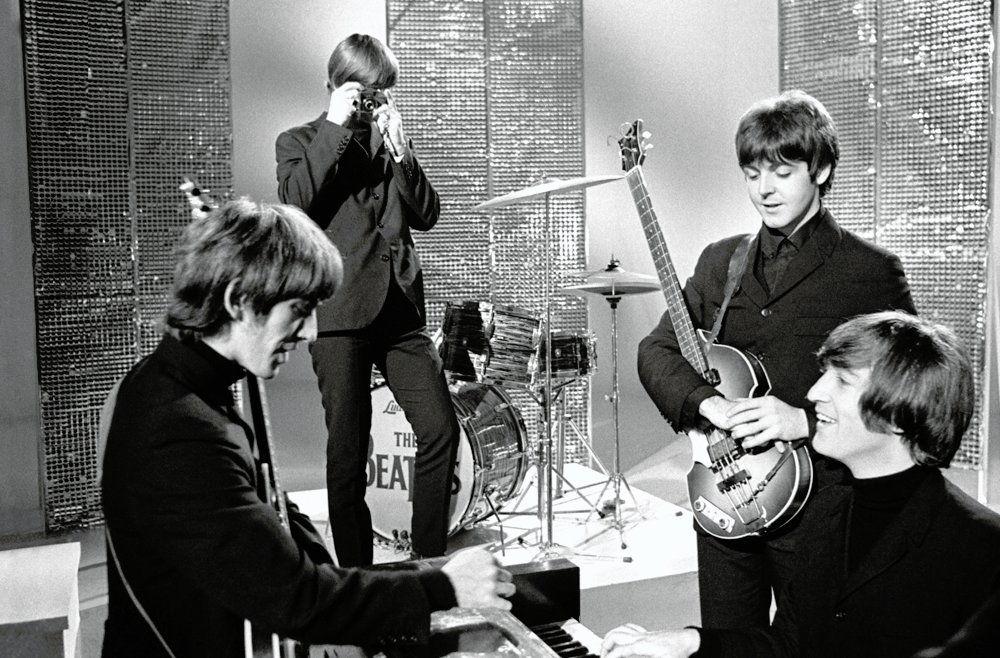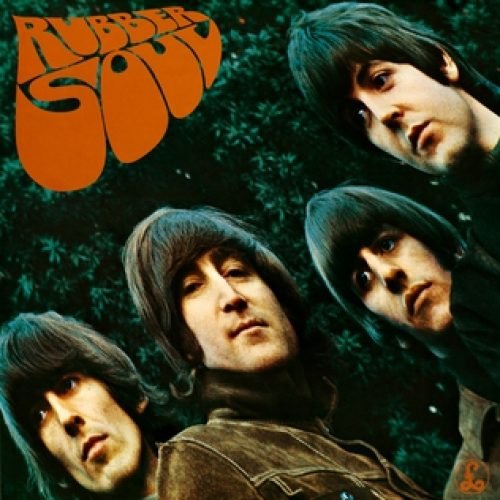Released in December 1965, “Rubber Soul” is often heralded as a pivotal moment not only in The Beatles‘ illustrious career but also within the broader landscape of popular music. Coming after their more pop-oriented early work, this album marks a distinct shift towards more complex themes, innovative production techniques, and an exploration of diverse musical styles. It’s nestled in their discography at a crucial juncture, following the energetic “Help!” and preceding the psychedelic revelations of “Revolver” and “Sgt. Pepper’s Lonely Hearts Club Band.” This positioning allows “Rubber Soul” to serve as a bridge of sorts – one that transitions The Beatles from pop sensations to studio artisans, deeply involved in crafting their sounds and narratives.
Artistic Intentions
The Beatles’ artistic intentions with “Rubber Soul” were multifaceted. Firstly, there was a clear desire to experiment and evolve. This was a time of intense creative ferment for the band, spurred on by their exposure to a wider array of musical influences, including folk, soul, and the burgeoning sounds of psychedelic rock. The folk music influence, in particular, is evident in the album’s more introspective lyrics and the use of acoustic instruments, a significant departure from their earlier, more straightforward rock and roll compositions. The Beatles were also beginning to experiment with the studio as an instrument in itself, exploring new recording techniques and sound textures.
Our whole attitude was changing. We’d grown up a little. I think grass was really influential in a lot of our changes especially with the writers.
Ringo Starr on Rubber Soul
Another layer of their artistic vision was the pursuit of deeper lyrical content. “Rubber Soul” reflects a move towards more personal, reflective, and even socially aware lyrics. This shift is part of what makes the album stand out in The Beatles’ discography; it’s where the band starts to deal with more complex emotional and social themes, moving away from the simpler love songs that had characterized much of their early work.

The album title itself, a play on the term “plastic soul” which Paul McCartney once described as the Beatles’ sly nod to their own take on the soul music of the era, suggests a self-awareness and a playful yet earnest attempt to blend authenticity with innovation. This intention to blend sincerity with a newfound complexity in both music and lyrics is at the heart of “Rubber Soul.” It represents The Beatles’ growing maturity as musicians and as people, signaling a readiness to push the boundaries of what pop music could be.
“Rubber Soul” did not just mark a departure; it was a declaration of artistic freedom and exploration that would define the rest of The Beatles’ career. Through this album, they aimed not only to satisfy the expectations of their global audience but to surpass them, charting new territory for all of popular music to follow. This ambition, coupled with the album’s reception and enduring influence, underscores its critical role in the evolution of The Beatles and the music of the 1960s.
Sonic Exploration

The Beatles’ “Rubber Soul” stands as a testament to the band’s burgeoning sonic exploration, showcasing a significant leap in production quality, musical arrangements, and genre experimentation. This album not only captures a moment of transformation for The Beatles but also reflects their desire to push the boundaries of what could be achieved within the confines of a pop album.
Production Quality
The production of “Rubber Soul” is a delicate balance of clarity and innovation. Under the guidance of producer George Martin, the album achieves a sound that is both polished and warm, eschewing the raw, lo-fi aesthetic that characterized some contemporary recordings for a more refined approach. This clarity in production allows the intricacies of the musical arrangements and the nuance of the lyrics to shine through. However, it’s the subtle experimentation with recording techniques, such as the use of varispeed to alter the pitch of vocals and instruments, that lends the album a distinctive texture. This innovative production style serves the album’s themes by creating an intimate atmosphere that draws listeners closer, making the introspective and sometimes whimsical lyrics more impactful.
Musical Arrangements
The musical arrangements on “Rubber Soul” are a highlight, showcasing The Beatles’ growth as musicians and their willingness to incorporate a diverse array of instruments. From the sitar on “Norwegian Wood (This Bird Has Flown)”—a pioneering moment in the popularization of Indian instruments in Western pop music—to the use of a fuzz bass on “Think for Yourself,” the album is replete with memorable arrangements. The vocal harmonies, a hallmark of The Beatles’ sound, also reach new levels of complexity and beauty, perfectly complementing the rich tapestry of sounds produced by the band and their session musicians. These arrangements not only contribute to the album’s distinctive sound but also underscore the themes of introspection, love, and social commentary that permeate the lyrics.
Genre Elements
“Rubber Soul” is remarkable for its eclectic mix of musical genres and subgenres, weaving together elements of folk, rock, pop, soul, and even classical music. This blend of genres is executed in a way that feels both novel and seamless, allowing the album to transcend traditional genre boundaries. The folk influence is particularly pronounced, with tracks like “Norwegian Wood (This Bird Has Flown)” and “Nowhere Man” reflecting the introspective, narrative-driven style of contemporary folk music. Yet, the album never feels tethered to one specific style; instead, it flows freely from the Motown-inspired “Drive My Car” to the baroque pop sensibilities of “In My Life,” showcasing The Beatles’ ability to synthesize diverse musical influences into a coherent, innovative whole.
Lyrical Analysis

“Rubber Soul” is a rich tapestry of lyrical innovation, marking a significant departure from the love-centric themes that dominated The Beatles’ earlier work. This album sees the band delving into more introspective and philosophical territories, exploring themes of love, identity, and social consciousness with a newfound maturity and complexity.
Themes and Messages
The central themes of “Rubber Soul” are as varied as its musical influences, ranging from introspective musings on personal growth and the human condition to more nuanced takes on romantic relationships. Songs like “Norwegian Wood (This Bird Has Flown)” and “Nowhere Man” epitomize this shift, with the former using narrative storytelling to explore the complexities of love and relationships, and the latter offering a meditation on alienation and the search for identity. Social commentary also weaves its way into the album, with “Drive My Car” offering a sly critique of ambition and materialism.
Recurring motifs of introspection and existential questioning link the album’s songs, with lyrics that often challenge listeners to look beyond the surface. This thematic cohesion gives “Rubber Soul” a conceptual unity, binding the tracks together into a coherent exploration of the human experience.
Lyrical Depth
The lyrics on “Rubber Soul” are characterized by their poetic nature and depth, marking a significant evolution in The Beatles’ songwriting. While the album retains the band’s knack for catchy, accessible lyrics, there is a noticeable shift towards more abstract and metaphorical language, inviting listeners to engage in multiple interpretations. For example, “In My Life” reflects on the passage of time and the memories that shape our identity, blending straightforward narrative with a contemplative depth that has made it one of The Beatles’ most beloved tracks.
The use of imagery and metaphor enriches the album’s lyrical landscape, imbuing songs with layers of meaning that reward repeated listens. This complexity not only showcases Lennon and McCartney’s growing prowess as lyricists but also signals a broader trend in popular music towards more sophisticated and varied lyrical content.
Emotional Impact
The emotional resonance of “Rubber Soul” is one of its most enduring qualities, with lyrics that range from the joyfully whimsical to the profoundly melancholic. The album’s exploration of love, loss, and longing strikes a universal chord, inviting listeners to reflect on their own experiences and emotions. Songs like “Michelle” and “Girl” evoke the sweetness and sorrow of love, while “In My Life” offers a poignant meditation on nostalgia and the passage of time.
The emotional impact of the album is heightened by its musical arrangements, which complement the lyrical themes with matching moods and atmospheres. This synergy between word and sound creates a deeply immersive listening experience, allowing the album to resonate on both an intellectual and emotional level.
Cohesion and Flow

The Beatles’ “Rubber Soul” is a masterclass in album cohesion and flow, showcasing an exceptional understanding of how to construct an album that moves gracefully from one track to the next, both musically and thematically.
Track Progression
“Rubber Soul” features a meticulously curated tracklist that ensures a smooth transition between songs, maintaining a balance between variety and cohesion. The album opens with the upbeat “Drive My Car,” setting a lively tone that gradually gives way to more introspective and nuanced tracks. The progression from the folk-inspired “Norwegian Wood” to the introspective “Nowhere Man,” and later to the emotional depth of “In My Life,” demonstrates a thoughtful arrangement that guides listeners through a diverse musical landscape while maintaining a narrative and emotional continuity.
The side two opener, “What Goes On,” and following tracks like “Girl” and “I’m Looking Through You” further exemplify this balance, weaving together themes of love, introspection, and personal growth. The album’s flow is so seamless that it feels like a journey, with each song serving as a chapter that builds upon the last, culminating in the reflective “Run for Your Life.” This narrative and emotional progression lends the album a story-like quality, enhancing its immersive experience.
Thematic Consistency
“Rubber Soul” maintains a high level of thematic consistency, with recurring themes of love, identity, and social consciousness woven throughout its tracks. Despite the variety of musical styles and influences present on the album, from folk and rock to pop and beyond, there is a unifying thread of introspection and emotional authenticity that runs through the lyrics and compositions. This thematic throughline ensures that the album feels like a cohesive work, rather than a collection of disparate songs.
Moreover, the emotional tone of the album is carefully managed to avoid jarring shifts, moving smoothly between the more upbeat tracks and the introspective, melancholic songs. This emotional balance is key to the album’s cohesion, as it mirrors the complexity of the human experience, blending moments of joy, reflection, and sadness into a unified whole.
The seamless integration of various musical genres, combined with a consistent exploration of deep and resonant themes, ensures that “Rubber Soul” stands out not only as a collection of songs but as a cohesive artistic statement. The Beatles’ ability to maintain thematic and emotional consistency across the album, while still exploring a diverse range of styles and topics, is a testament to their maturing artistry and vision during this period in their career.
Standout Tracks and Moments

“Rubber Soul” is an album replete with moments of innovation, emotional depth, and artistic brilliance. Among its uniformly strong tracks, several stand out for their particular contributions to the album’s legacy and for showcasing The Beatles’ evolving artistry. These key tracks and memorable moments underscore the band’s musical and lyrical prowess, marking “Rubber Soul” as a pivotal point in their discography.
Key Tracks
“Norwegian Wood (This Bird Has Flown)” stands out for its introduction of the sitar, played by George Harrison, marking one of the first uses of Indian instruments in Western pop music. This track is not only significant for its musical innovation but also for its storytelling, offering a narrative of a failed romantic encounter that is both poignant and cryptic, wrapped in layers of metaphor and innuendo.
“In My Life” is widely celebrated for its lyrical depth and emotional resonance. Reflecting on the passage of time and the memories that define us, the song strikes a universal chord. Its melodic line, combined with a harpsichord bridge that lends a baroque feel, showcases The Beatles’ ability to blend traditional and contemporary elements in new and meaningful ways.
“Nowhere Man” is notable for its introspective lyrics, addressing feelings of alienation and existential questioning. It represents a significant thematic departure from the love songs that had previously dominated their repertoire, offering instead a deeply personal and reflective piece that resonates with listeners on a profound level.
Memorable Moments
The sitar intro on “Norwegian Wood (This Bird Has Flown)” is one of the album’s most iconic moments, immediately transporting listeners to a sonic landscape that was entirely new to most Western ears at the time. This single moment symbolizes the band’s readiness to explore beyond the boundaries of rock and pop, setting the stage for future musical explorations.
The harmonized vocal break in “Nowhere Man” showcases The Beatles’ vocal talents and their ability to create complex and beautiful harmonies. This moment captures the essence of the album’s introspective and contemplative mood, highlighting the band’s unity and cohesion as a group.
The piano solo in “In My Life,” played by producer George Martin and sped up to resemble a harpsichord, stands out as a poignant moment of reflection. This instrumental break, nestled within a song deeply concerned with memory and the passage of time, serves as a musical metaphor for the fleeting nature of life and the enduring power of love.
Each of these standout tracks and moments contributes to the overall impact of “Rubber Soul,” showcasing The Beatles’ artistic growth and their willingness to push the boundaries of popular music. The album’s blend of musical innovation, lyrical depth, and emotional resonance is encapsulated in these key moments, solidifying “Rubber Soul” as a landmark achievement in the band’s history and in the annals of modern music.
Artistic Contribution and Innovation

“Rubber Soul” not only stands as a monumental album within The Beatles’ discography but also occupies a pivotal place in the music industry and the broader landscape of popular music. Its release in December 1965 marked a moment of profound artistic evolution for the band and signaled a shift in the possibilities of what a pop album could achieve, both technically and thematically. The album’s innovations and its break from established norms have cemented its legacy as a work of significant artistic contribution.
Place in Genre/Industry
Within the context of its genre, “Rubber Soul” is often celebrated for its role in expanding the boundaries of rock and pop music. The album eschewed the formulaic structures of early rock and roll in favor of more complex compositions, varied musical influences, and introspective lyrics. This departure not only showcased The Beatles’ growth as artists but also challenged the industry’s prevailing notions of what popular music could encompass. “Rubber Soul” played a crucial role in elevating the album as a cohesive art form, moving away from the singles-dominated market of the early 1960s. Its influence is seen in the way it inspired contemporaries and future generations to view the album as a canvas for broader artistic expression, paving the way for the concept albums of the late 1960s and beyond.
Innovation
Production Techniques
Under the guidance of producer George Martin, “Rubber Soul” utilized innovative studio techniques that would become hallmarks of The Beatles’ later work. The use of varispeed on “In My Life,” the creative mic placements, and the pioneering use of the sitar on “Norwegian Wood” are just a few examples of how the album pushed technical boundaries. These techniques not only enhanced the album’s sound but also broadened the palette of textures available to pop and rock musicians.
Musical Arrangements
The album’s blend of musical styles—from rock, pop, and folk to elements of classical and Indian music—demonstrated an adventurous and open-minded approach to songwriting and composition. This genre-blending not only set “Rubber Soul” apart from its contemporaries but also contributed to the expanding musical vocabulary of popular music.
Thematic Exploration
“Rubber Soul” marked a significant leap forward in terms of lyrical sophistication. By tackling themes of love, identity, and social awareness with greater depth and nuance, The Beatles elevated the lyrical standards of rock and pop music. The introspective and philosophical nature of the album’s lyrics encouraged listeners to expect more from pop music, influencing the thematic ambitions of countless artists to follow.
“Rubber Soul” represents a watershed moment in The Beatles’ career and the evolution of popular music. Its artistic contributions and innovations reshaped the musical landscape, challenging artists to explore new thematic territories and to experiment with the sonic possibilities of the studio. The album’s enduring influence is a testament to its pioneering spirit, marking it as a cornerstone of modern music’s ongoing evolution.
Closing Thoughts

“Rubber Soul” stands as a monumental achievement in the annals of popular music, representing a pivotal moment in The Beatles’ career and a transformative work within the music industry at large. This album encapsulates the band’s transition from pop sensations to musical innovators, setting new benchmarks for artistic expression in rock and pop music. Its strengths are manifold, from the sophisticated lyrical themes to the pioneering production techniques and the seamless integration of diverse musical styles.
The album’s few weaknesses, if any, are overshadowed by its groundbreaking contributions and the sheer scope of its influence. Perhaps the only critique could be that in its groundbreaking nature, “Rubber Soul” left fans and contemporaries yearning for more, setting expectations incredibly high for future works. Yet, this too speaks to the album’s strength and the fertile creative ground it cultivated.
The impact of “Rubber Soul” on listeners and its place in The Beatles’ career cannot be overstated. It challenged and expanded the listeners’ expectations of what popular music could be, both in terms of its sonic landscape and its thematic depth. For The Beatles, it marked the beginning of their most artistically fruitful period, leading to a series of albums that would continue to revolutionize the music world.
Official Rating
In light of these considerations, it is fitting to award “Rubber Soul” a perfect rating of 10 out of 10. This score is not just a reflection of the album’s near-flawless execution but also an acknowledgment of its enduring impact on the music industry and popular culture. “Rubber Soul” is not merely a collection of songs but a landmark artistic statement that resonates with listeners across generations. Its perfect rating is a testament to its innovation, its emotional depth, and its pivotal role in charting a new course for popular music.
